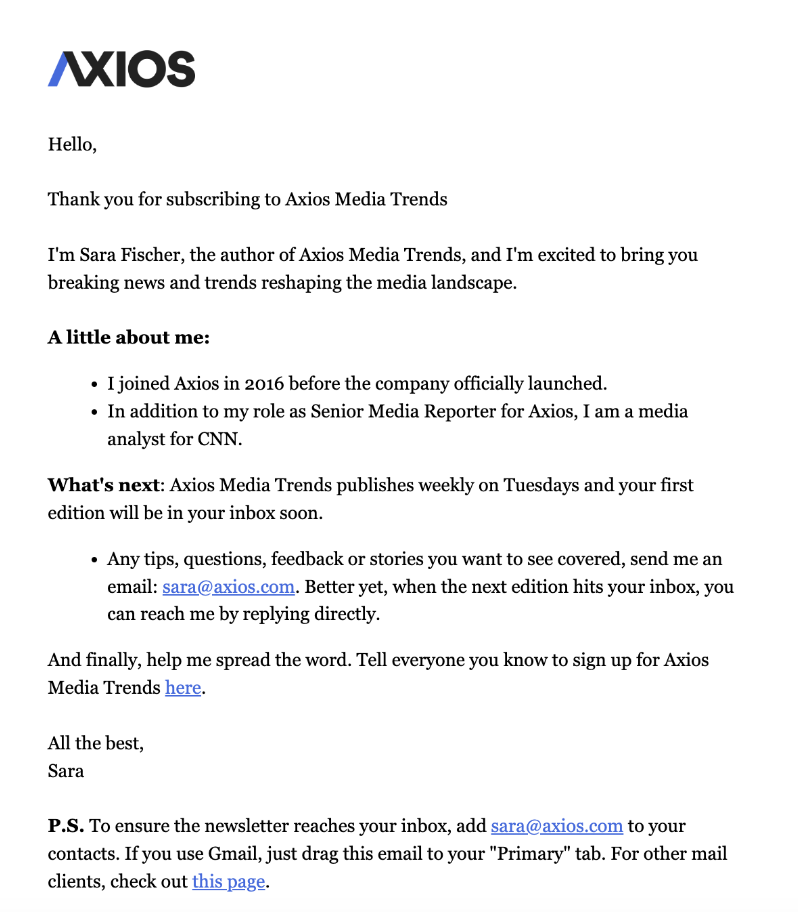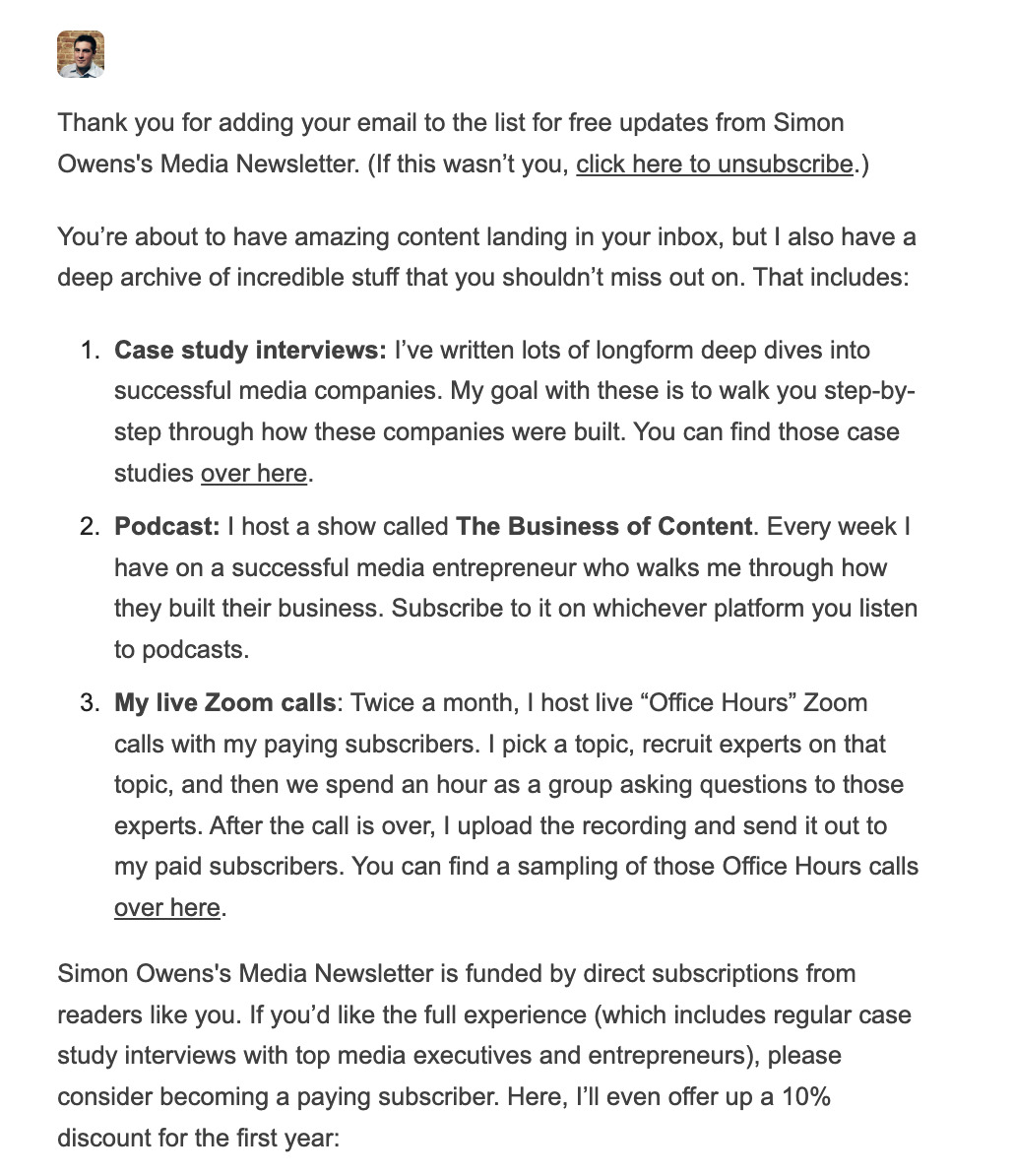Need to engage new subscribers? Fix this one thing.
Last updated: May 13, 2024

As a terminally online writer, I sign up for a lot of newsletters. But I’m also a busy professional with a short attention span, so I forget about most of them right away.
I’m not alone: Lots of people subscribe to newsletters on a whim, only to lose interest once you hit their inbox. That hurts your engagement rates and threatens your deliverability. Worse, it keeps you from creating the consistent audience base you need to grow your business.
So how can you keep your subscribers engaged after they sign up? Sending an effective subscription confirmation email.
Get ahead with innovative marketing automation! Unleash conversions & engage audiences:
You’re only guaranteed to get someone to open and click your email when they’re confirming their subscription. So this is your time to shine! With this email, you need to capitalize on their excitement when it’s at its highest — and get them in the habit of reading.
Or in other words: Neglecting your subscription confirmation email is like inviting someone to a party and leaving them at the door. Sure, you’ve got them in. But they don’t know what to do — and they won’t stick around long.
So what goes into a good subscription confirmation email? The best ones:
- Remind readers what content and resources they can expect from you
- Demonstrate your credibility
- Tell readers how to retrieve your emails from their promotions and spam folders
- Get readers in the habit of consistently reading your emails
- Spark a connection with your subscribers — and keep them coming back for more!
In this post, learn how to create subscription confirmation emails that keep your new email subscribers engaged long after your first send.
How to create a perfect subscription confirmation email
1. Convey gratitude
Newsletters are a labor of love. You share your expertise, personality and your heart with your subscribers — and this virtual stranger has decided to open their mind (and inbox) to it. Starting your newsletter with a heartfelt “thank you” tells your new subscribers that you see and value their contribution. What better way to start a new relationship?
2. Spark excitement with your subject line
Sure, “subscription confirmed” gets the job done. But it inspires a passive response — people can say, “Great, that form went through,” and delete. It doesn’t entice new subscribers to click through and learn more.
Instead, inspire your new subscribers to act with an enthusiastic subject line. This doesn’t have to be groundbreaking, just genuine. Some subject lines we like:
- “Welcome on board!”
- “🤗 Welcome to the Reuters Institute”
- “Thanks for subscribing! Let’s get you up to speed”
No two audiences are the same, so A/B test your subject lines to see what variations get the most responses. (On our email and marketing automation platform, you can create up to five test splits.)
3. Allow users to submit their preferences
The more subscribers can customize their experience, the more likely they are to stay actively engaged.
So in your subscription confirmation email, link to a preference page where subscribers can tell you their preferences. If you have multiple newsletters, have users select their desired newsletters in a menu. Or if you only have one, list different sub-topics and have users indicate what kinds of content they’re interested in receiving from you.
Or have readers choose their sending frequency (for example, daily or weekly sends). Your readers will be less fatigued and less likely to report spam. Subscriber satisfaction aside, this also boosts your engagement numbers and lowers your chances of experiencing deliverability issues.
The benefits go beyond your stats: Your preference pages give you a starting point for building each new customer’s profile. Use this to identify key coverage topics, unseen opportunities and inform your segmentation efforts. (And create even better content moving forward!)
The hard part here is getting everyone’s responses into your email platform quickly enough to make an impact. Using a customer data platform (CDP) like Omeda can streamline this process immensely, Here’s how it works:
- CDPs take in customer data from every touchpoint to create a single profile for each person that encompasses every channels (website, email, print, you name it). This happens nightly according to a series of automated workflows – no manual inputs required.
- That means that every preference page response is added to the person’s customer profile in real time.
- And those responses are immediately available to your email team, who can use that information to build marketing segments and personalize their content much more quickly.
- Bonus: Omeda’s CDP is connected to an email and marketing automation platform, so you can simplify this process even further.
4. Demonstrate your credibility or social proof
Everyone has a platform these days. But only experts can provide consistent value over time. Reminding your readers of your credibility builds trust and encourages them to keep engaging. So devote some space in your subscription confirmation email to your background and interest in the topic.
Not sure where to start? Here’s a great example from Axios Media Trends, in which Sara Fischer uses her extensive media reporting experience to comment on current media industry trends.

Don’t feel like bragging? Mention the number of subscribers you have (“70,000 people receive our financial news updates every week”) or include a quote from a happy reader instead.
5. Give subscribers a taste of what’s to come
Remind people why they cared enough to subscribe. Briefly discuss all the knowledge, resources and perks they have to look forward to. Be sure to highlight any subscriber-exclusive content (like additional resources, access to a subscriber community, or professional consulting services).
Also mention your scheduled send days and time so they can set their clock to your content.
Want to take it a step further? Link to your past newsletters and best resources.
Simon Owens, the author of Simon Owens’ Media Newsletter, does this to perfection in his newsletter’s subscription confirmation email. He doesn’t just say he covers the media business — he proves it by linking to a host of case studies, podcasts and articles on those topics. This gives people multiple opportunities to engage with his content and deepen their interest — all from one email.
6. Include whitelisting instructions
In a perfect world, your emails would be top of inbox every time. Unfortunately, getting in front of your subscribers is more complicated than that — and not just because of the competition.
Gmail uses a complex algorithm to decide whether to send your emails to recipients’ primary inboxes, promotions tabs, or spam. And one the biggest factors in that algorithm is previous engagement.
When you’re trying to engage brand-new subscribers, that’s a problem.
If your subscribers haven’t engaged with your emails yet, those messages are more likely to get buried in Promotions or spam. And unless your subscribers care enough to seek out your email (unlikely unless you’re a huge brand), your relationship with them could end before it begins.
Prevent this by encouraging readers to add you as a contact. This tells their inbox service provider that you’re a familiar sender and guarantees that future messages will land in their main inbox.
Also remind them to check their Gmail Promotions or spam folder if they don’t receive your emails — and ask them to move you to the main inbox (another reason to tell readers your sending schedule!).
7. A human touch
As you write your email, think about why you love your favorite newsletters. Most likely, it’s not just because of the knowledge and facts. It’s because you can connect to the writer — they share stories and advice in a human and relatable way.
Humanize your newsletter early in your subscription confirmation email: Use a friendly first person tone and sign off with your first name. Unless your content is super dense, speak in your own words and stay away from the five-dollar phrases. And if your brand guidelines allow, slip in a pun or pop culture reference in too.
After all, you’re looking to create a long-term relationship with your subscribers. And you can’t do that unless they see the real you.
Subscribe to our newsletter
Sign up to get our latest articles sent directly to your inbox.
What you should do now
- Schedule a Demo to see how Omeda can help your team.
- Read more Marketing Technology articles in our blog.
- If you know someone who’d enjoy this article, share it with them via Facebook, Twitter, LinkedIn, or email.
